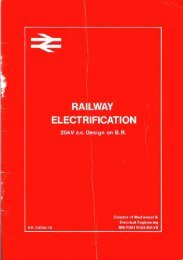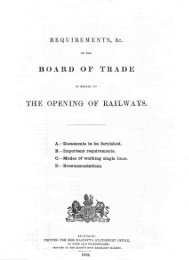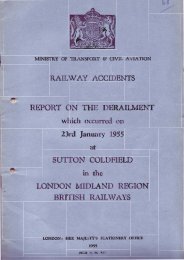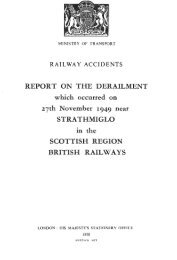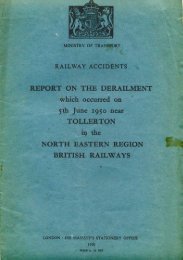R A I LT R AC K - The Railways Archive
R A I LT R AC K - The Railways Archive
R A I LT R AC K - The Railways Archive
Create successful ePaper yourself
Turn your PDF publications into a flip-book with our unique Google optimized e-Paper software.
freight<br />
We are building on<br />
the opportunities that<br />
we have identified to<br />
improve the transfer<br />
of freight between<br />
road and rail<br />
92<br />
7.6 continued 7.7<br />
We have identified a further 17 route sections from our<br />
own and other property portfolios that we may reopen in<br />
the next few years (see Table F).Protecting disused sites and<br />
terminals is a vital challenge to everyone involved in the rail<br />
freight industry. As the Sustainable Distribution document<br />
notes it is particularly important that the relevant planning<br />
guidance recognises the need to retain locations where<br />
there is a realistic prospect of future traffic.<br />
From the first phase of our work with the Highways<br />
Agency in England and the National Roads Directorate in<br />
Scotland, we are building on the opportunities that we have<br />
identified to improve the transfer of freight between road<br />
and rail. We support the policy of a national framework for<br />
major freight interchanges.Our role is to secure suitable<br />
locations,facilitate their connection to our network and the<br />
agencies trunk road network, and to develop them provided<br />
that there is a sensible commercial opportunity and to the<br />
extent that others do not take the lead on individual<br />
projects.<br />
To underpin this development work and to enable local<br />
authorities to contribute further to the development of rail<br />
freight opportunities, we will be shortly publishing a new Rail<br />
Freight Reference Bookin partnership with representatives of<br />
local authorities and the freight operators.<br />
7.7 Progress with our Ten-Point Plan<br />
In April 1997, we summarised our initial plans to develop rail<br />
freight in a Ten-Point Plan.Since then,the industry has made<br />
enormous progress.As we have set out below, some of the<br />
issues we identified in the Plan have been addressed,while<br />
new challenges have arisen.<br />
1. Reduction in costs<br />
On the basis that we have previously measured our costs,<br />
we have continued to make progress in reducing them.Our<br />
unit prices to freight customers fell by 7.9% last year while<br />
our unit costs fell by 9.7% (see Table G opposite).<br />
However, during the year, we have reviewed in more<br />
detail the composition of the fixed and variable costs that<br />
we incur in handling particular types of rail freight traffic on<br />
certain routes.Although the overall totals of prices and costs<br />
are in line with each other, and our pricing structures are<br />
consistent with the Rail Regulator policies, we may need to<br />
restructure future track access arrangements to better<br />
reflect our new understanding of cost causation.This shows<br />
that the variability of our costs as a result of changes in the<br />
volume of traffic over the network,is much higher than the<br />
current access charges assume. We are discussing this issue<br />
with industry stakeholders who share our concern that any<br />
necessary increase in our marginal prices to reflect costs,<br />
might affect anticipated growth (see also Section 1.5).<br />
2. Better routes for freight<br />
In publishing the route directory in CD-ROM fo rmat and on<br />
the Internet (www. f r e i g h t . c o m m e r c i a l . c o. u k ) ,we completed<br />
the fi rst stage of documenting the current chara c t e ristics of<br />
the netwo rk . Since then, we have begun wo rk on assessing the<br />
n e t wo rk ’s potential capability and have set out how we want<br />
to improve it further in our freight route stra t e g y.We have<br />
also introduced the ‘ F r e i g h t w ay ’c o n c e p t , a domestic ve rsion of<br />
the Trans-European Freight Freeways promoted by the EU, t o<br />
identify existing capacity on the netwo rk in anticipation of<br />
m a rket demand.<strong>The</strong> fi rst phase of this wo rk highlighted 27<br />
r e t u rn , long-distance paths on fi ve key freight routes with<br />
d e p a rt u r e, a rrival and transit times that are competitive with<br />
r o a d . EWS has since taken up two of these paths.<br />
3. Service improvements – reduction in delays<br />
Freight customers have also benefited from the<br />
improvements in Railtrack’s service performance. In the<br />
Ten-Point Plan, we set ourselves a target reduction of 5%.<br />
Total-minutes delay in 1997/98 were reduced by 21% while<br />
the number of trains increased by 5%.Delays per train fell to<br />
less than five minutes on average.We expect these trends to<br />
continue.We have not yet been able to provide specific<br />
information about the performance of our freight-only lines<br />
but expect to have fulfilled this customer requirement by<br />
July 1999.



